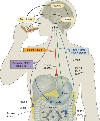Binge eating disorder
- PMID: 35301358
- PMCID: PMC9793802
- DOI: 10.1038/s41572-022-00344-y
Binge eating disorder
Abstract
Binge eating disorder (BED) is characterized by regular binge eating episodes during which individuals ingest comparably large amounts of food and experience loss of control over their eating behaviour. The worldwide prevalence of BED for the years 2018-2020 is estimated to be 0.6-1.8% in adult women and 0.3-0.7% in adult men. BED is commonly associated with obesity and with somatic and mental health comorbidities. People with BED experience considerable burden and impairments in quality of life, and, at the same time, BED often goes undetected and untreated. The aetiology of BED is complex, including genetic and environmental factors as well as neuroendocrinological and neurobiological contributions. Neurobiological findings highlight impairments in reward processing, inhibitory control and emotion regulation in people with BED, and these neurobiological domains are targets for emerging treatment approaches. Psychotherapy is the first-line treatment for BED. Recognition and research on BED has increased since its inclusion into DSM-5; however, continuing efforts are needed to understand underlying mechanisms of BED and to improve prevention and treatment outcomes for this disorder. These efforts should also include screening, identification and implementation of evidence-based interventions in routine clinical practice settings such as primary care and mental health outpatient clinics.
© 2022. Springer Nature Limited.
Conflict of interest statement
Competing interests
C.M.B. reports: Shire (grant recipient, Scientific Advisory Board member); Idorsia (consultant); Lundbeckfonden (grant recipient); Pearson (author, royalty recipient); Equip Health Inc. (clinical advisory board). F.F-A. received consultancy honorarium from Novo Nordisk and editorial honorarium as EIC from Wiley. P.H. is a consultant to Takeda Pharmaceuticals. All views in this paper are her own. P.H. receives or has received sessional fees and lecture fees from the Australian Medical Council, Therapeutic Guidelines publication, and New South Wales Institute of Psychiatry and royalties/honoraria from Hogrefe and Huber, McGraw Hill Education, and Blackwell Scientific Publications, Biomed Central and PlosMedicine and she has received research grants from the NHMRC and ARC. She is Chair of the National Eating Disorders Collaboration Steering Committee in Australia and was Member of the ICD-11 Working Group for Eating Disorders and was Chair Clinical Practice Guidelines Project Working Group (Eating Disorders) of RANZCP.
All other authors declare no competing interests.
Figures





References
-
- American Psychiatric Association. in Diagnostic and statistical manual of mental disorders: DSM-5 (American Psychiatric Assoc., Washington, DC, 2013).
-
- World Health Organization. ICD-11: International classification of diseases (11th revision)., <https://icd.who.int/> (2019).
Table 2 References
-
- Parker K, Brennan L. Measurement of disordered eating in bariatric surgery candidates: A systematic review of the literature. Obes Res Clin Prac 2015; 9(1): 12–25. - PubMed
-
- Gormally J, Black S, Daston S, Rardin D. The assessment of binge eating severity among obese persons. Addict Behav 1982;7(1):47–55. - PubMed
-
- van Strien T, Frijters JER, Bergers GPA, Defares PB. The Dutch Eating Behaviour Questionnaire (DEBQ) for Assessment of Restrained, Emotional, and External Eating Behavior. Int J Eat Disord 1986; 5(2):295–315.
-
- Fairburn CG. Eating Disorder Examination Questionnaire (EDE-Q 6.0). In: Fairburn CG, Beglin S, editors. Cognitive behaviour therapy and eating disorders. New York: Guild-ford Press; 2008.
Publication types
MeSH terms
Grants and funding
LinkOut - more resources
Full Text Sources

